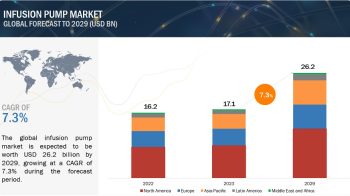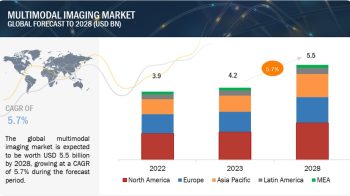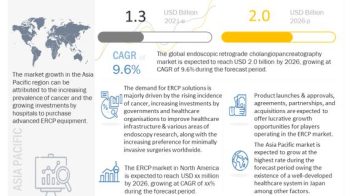Overview:
This study involved four major activities in estimating the size of brain monitoring market. Exhaustive secondary research was done to collect information on the market, peer market, and parent market.
The next step was to validate these findings, assumptions, and sizing with industry experts across value chains through primary research. The bottom-up approach was employed to estimate the overall market size. After that, market breakdown and data triangulation were used to estimate the market size of segments and sub-segments.
Expected Revenue Gains:
The global brain monitoring market size is projected to reach USD 8.0 billion by 2026 from USD 5.8 billion in 2021, at a CAGR of 6.5%.
Download PDF Brochure@
https://www.marketsandmarkets.com/pdfdownloadNew.asp?id=909
Major Growth Boosting Factors:
The brain monitoring market is mainly driven by factors such as the increasing incidence and prevalence of neurological disorders, rising awareness of neurodegenerative diseases, growth in the number of traumatic brain injuries, and growing applications of brain monitoring in clinical trials.
On the other hand, the high cost of complex brain monitoring procedures and devices, unfavorable reimbursement policies, and the shortage of trained professionals to effectively operate brain monitoring devices are restraining the growth of this market.
Impact of covid-19 on The brain monitoring Market
The state of urgency to combat the outbreak has led to a significant increase in the demand for remote monitoring and patient engagement solutions. Most of the hospitals/healthcare facilities are currently trying to expand patient monitoring to home care settings or other temporary setups with an aim to provide optimal care. COVID-19 has led to a significant surge in demand for ventilators, and manufacturers are currently focusing their efforts to meet the increasing need for ventilators, including other respiratory devices, in contrast to brain monitoring devices. The pandemic is likely to have an adverse impact on the brain monitoring business, particularly due to the focus of hospitals on setting up COVID-19 specific ICUs, along with the temporary suspension of production and manufacturing sites in major affected regions across the globe.
The devices segment accounted for the largest share 74.9% of the brain monitoring market.
By product, the global brain monitoring market is categorized into devices and accessories. The devices segment held the largest share 74.9% of the brain monitoring market in 2020. This is mainly due to the rising incidence of neurological, neurodegenerative, psychotic, and sleep disorders, the need for early diagnosis, the availability of innovative portable and wearable home-based monitoring devices, and increasing patient awareness.
Hospitals accounted for the largest share 57.8% of the end user segment of the brain monitoring market.
Based on end-users, the global brain monitoring devices market is segmented into hospitals, neurology centers, diagnostic centers, ASCs & clinics, and other end users. The hospital segment held the largest share 57.8% of the global brain monitoring market in 2020. Brain monitoring is a complex process, requiring expensive and advanced devices and equipment that are mainly found in hospitals. Hospitals also see a considerably larger inflow of patients as compared to small clinics and other end users. Additionally, brain monitoring devices pose a considerable burden in terms of maintenance expenses on healthcare facilities; hospitals, more than other end-users, can bear such costs. Hence, brain monitoring devices are mostly used in hospitals, which consequently account for the largest share of this market segment.
North America accounted for the largest share 38.0% of the global brain monitoring market
North America, Europe, the Asia Pacific, and the Rest of the World. North America held the largest share 38.0% of the global brain monitoring market in 2020, while the Asia Pacific is projected to be the fastest-growing region in the forecast period. The high growth rate of the market in the Asia Pacific region can be attributed to the availability of low-cost labor and skilled manpower, increase in disposable incomes, rising prevalence of neurodegenerative disorders, and increasing government emphasis on healthcare reforms in the region.
Request Sample Pages@
https://www.marketsandmarkets.com/requestsampleNew.asp?id=909
Key Players:
Some of the leading players in the Brain Monitoring market include Natus Medical, Inc. (US), Nihon Kohden Corporation (Japan), Philips Healthcare (Netherlands), GE Healthcare (US), Siemens Healthineers (Germany), Compumedics, Ltd. (Australia), Medtronic (Ireland), Edwards Lifesciences Corporation (US), Drägerwerk AG & Co. KGaA (Germany), Advanced Brain Monitoring (US), Masimo Corporation (US), Spiegelberg GmbH & Co. KG (Germany), Cadwell Industries (US), NeuroWave Systems, Inc. (US), Nonin Medical, Inc. (US), Integra LifeSciences Corporation (US), Neurosoft (Russia), CGX (a Cognionics Company) (US), Emotive (US), InfraScan, Inc. (US), Neusoft Medical Systems Co., Ltd. (China), Clinical Science Systems (Netherlands), Noraxon (US), SternMed GmbH (Germany), and Rimed (US).


